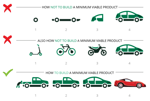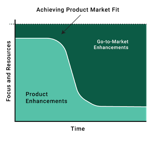This article first appeared in the Union Leader in April 2022
Navigating the product lifecycle at a startup can be challenging. You have limited resources, time and money, and all anyone wants to know is “When will we have product market fit?”
There’s an infinite amount of advice you’ll receive in this moment, but understanding these three components of product market fit can help you navigate your own unique path to finding product market fit.
There are three foundational major components of achieving product market fit: product, positioning and audience. I like to think about these as the following:
Product or minimum viable product — a functional and sellable product that accomplishes the basic needs of your target audience.
Audience or minimum viable audience — the most focused subsegment of your target market, that you believe is accessible and interested in your product, and is large enough to sustain your immediate revenue needs.
Positioning — the messaging, process and approach for how you’ll bring your product to market. This is like your playbook connecting your product to the audience.
Minimum viable products
A minimum viable product is a starting point for introducing your product to customers. When planning for your MVP there are some guidelines that will help optimize your success.

The ruthless prioritization of product features is essential in reducing the scope, and therefore reducing the development time. The earlier you can launch your product to the market, the sooner you can enable feedback from customers on your product and revenue to support the business. Client feedback and revenue are the lifelines of your future product iteration.
As you continue to do planning for your product’s roadmap, you’ll incorporate feedback on both the desirability and the usability of your product.
Signs of product market fit can happen on a per feature basis as well. If you notice certain features being called upon as essential by your customers, and there is usability feedback like quality or user experience, be sure to prioritize those enhancements to “double down” on what is working.
The feedback from your clients isn’t just useful in tuning the product, however. It’s extremely important to use this feedback to tune your understanding of your audience, too.
Minimum viable audience
Your target audience is essential to get right in the early days. One way to increase your odds of success is to think about this as your minimum viable audience. It’s fantastic to have a big vision for your startup, with large target markets, but the more specific you can be with your MVA at launch, the more focused your company can be.
I like to think about an MVA that is niche, focused, accessible and well known by me and my employees. I like to know as much about their use case, plans to adopt my product, ability to pay for the product, and where I can access this audience. The feedback you’ll receive in the early days as you begin to speak to your potential customers may continue to tune who you think is the right audience.
This is expected, but also don’t pivot too fast. You’ll need to talk to tens or hundreds of potential customers before you may really be able to understand essential updates needed in your approach. This is what product positioning is all about.
Positioning
In football, teams have playbooks that pull together the strengths and skills of that team into choreographed plays where everyone knows their role. Even though each opponent may be different, the playbook has enough options to navigate these scenarios.
Positioning is the playbook for your startup, informing how you bring your product to your target audience. You’ll take into account your startup’s competitors, alternatives, differentiators, specific value to customer, pricing, packaging and more… This is where the art happens, and it should be under constant iteration, update and refining.

The outputs of positioning are often a bunch of processes and collateral. Things like your sales and onboarding process, marketing collateral like case studies, one pagers, and even your website messaging is all part of your positioning.
The hierarchy of positioning can often be thought of like:
Mission and vision — the high level of where you’re going.
Descriptor or tagline — how do you sum up what you do.
Use cases — what are the main things your product can do.
Solutions — what are the outcomes of using your product in different ways.
Achieving product market fit
As you begin to achieve product market fit, you’ll notice shorter sales cycles, more market pull requesting your product, less advertising needs and lower customer churn.
The more you notice these signs, the more you can continue to shift resources toward go-to-market efforts at your startup. Until then… keep iterating and your product and audience.
In our experience, it never happens as fast as you’d hope, but there really is nothing better to an entrepreneur than seeing their vision come to life.
Mike Veilleux is the technical co-founder and chief technical officer of York IE, where he is responsible for product development and product strategy.
